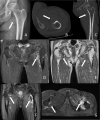Case Report: A case of femoral metastatic cancer misdiagnosed as isolated femoral lesser trochanter avulsion fracture
- PMID: 40599861
- PMCID: PMC12209255
- DOI: 10.3389/fonc.2025.1565771
Case Report: A case of femoral metastatic cancer misdiagnosed as isolated femoral lesser trochanter avulsion fracture
Abstract
Objective: To highlight the diagnostic challenges and clinical implications of metastatic disease presenting as an atypical fracture in a patient with a history of lung cancer, emphasizing the importance of maintaining a high index of suspicion for metastatic disease and the need for comprehensive diagnostic approaches.
Methods: We present a case of a 79-year-old male with a history of poorly differentiated squamous cell carcinoma of the left lung who presented with left hip pain after minor trauma. Initial X-ray and CT imaging suggested an avulsion fracture of the femoral lesser trochanter(LT).The patient was managed conservatively with bed rest. However, persistent pain led to further evaluation with MRI, revealing an underlying pathological fracture due to metastatic cancer.
Results: Initial radiographic and CT findings showed a localized bone defect and surrounding soft tissue swelling, consistent with an avulsion fracture of the LT. However, MRI and contrast-enhanced MRI revealed irregularities in the femoral LT with abnormal bone marrow signals and a prominent soft tissue mass, leading to the diagnosis of a pathological fracture secondary to metastatic cancer. This case underscores the limitations of initial imaging modalities in detecting subtle bone marrow changes and the importance of MRI in identifying metastatic lesions.
Conclusion: The misdiagnosis of a pathological fracture as an avulsion fracture can have significant clinical implications, including increased morbidity and delayed treatment of metastatic disease. This case highlights the importance of maintaining a high index of suspicion for metastatic disease, especially in patients with a history of malignancy, and the need for comprehensive diagnostic approaches, including MRI to avoid misdiagnosis. Early recognition and appropriate management of pathological fractures are crucial for improving patient outcomes and quality of life.
Keywords: case report; computed tomography; isolated femoral lesser trochanter fracture; magnetic resonance imaging; metastatic.
Copyright © 2025 Pang, Wu, Chen, Zhu, Jin, Gong and Jiang.
Conflict of interest statement
The authors declare that the research was conducted in the absence of any commercial or financial relationships that could be construed as a potential conflict of interest.
Figures

Similar articles
-
Femoral neck fractures after removal of hardware in healed trochanteric fractures.Injury. 2017 Dec;48(12):2619-2624. doi: 10.1016/j.injury.2017.11.031. Injury. 2017. PMID: 29223594
-
Delayed Deep Femoral Artery Injury Secondary to Migrated Lesser Trochanter Fragment After Intertrochanteric Fracture Fixation: A Case Report and Updated Literature Review.Geriatr Orthop Surg Rehabil. 2025 Jun 17;16:21514593251351188. doi: 10.1177/21514593251351188. eCollection 2025. Geriatr Orthop Surg Rehabil. 2025. PMID: 40535321 Free PMC article.
-
[Ipsilateral femoral neck fracture after fixation of intertrochanteric fracture by InterTAN intramedullary nail: A case report].Beijing Da Xue Xue Bao Yi Xue Ban. 2025 Jun 18;57(3):610-613. doi: 10.19723/j.issn.1671-167X.2025.03.028. Beijing Da Xue Xue Bao Yi Xue Ban. 2025. PMID: 40509842 Free PMC article. Chinese.
-
The value of FDG positron emission tomography/computerised tomography (PET/CT) in pre-operative staging of colorectal cancer: a systematic review and economic evaluation.Health Technol Assess. 2011 Sep;15(35):1-192, iii-iv. doi: 10.3310/hta15350. Health Technol Assess. 2011. PMID: 21958472 Free PMC article.
-
Treatment for osteoporosis in people with beta-thalassaemia.Cochrane Database Syst Rev. 2023 May 9;5(5):CD010429. doi: 10.1002/14651858.CD010429.pub3. Cochrane Database Syst Rev. 2023. PMID: 37159055 Free PMC article.
References
-
- Hayashi K, Takenaka S, Ohshika S, Kawashima H, Endo M, Kobayashi E, et al. Comparative surgical invasiveness of internal fixation for pathological fractures in metastatic bone disease versus traumatic fractures: a quantitative analysis of operative time and blood loss. Jpn J Clin Oncol. (2025) 55:615–20. doi: 10.1093/jjco/hyaf039 - DOI - PubMed
Publication types
LinkOut - more resources
Full Text Sources

